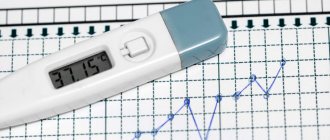PMS can manifest itself in different ways; some women notice an increase in temperature before their period. Such changes are caused by certain physiological processes in the body, but may indicate the presence of inflammatory, infectious pathologies, or pregnancy.
An increase in temperature before menstruation may indicate the development of abnormalities
What should be the temperature before menstruation?
An increase in temperature to a low-grade level shortly before menstruation is a normal occurrence for many women. Before menstruation, the level of progesterone in the blood increases - this hormone affects the reproductive system and the thermoregulation center, which is located in the brain. Therefore, a body temperature in the range of 37.1–37.5 without other signs of deterioration in health is not considered a pathology.
An indicator of the state of women's health is not only body temperature, but also rectal values; BT should be measured not only in the rectum, but also in the vagina, under the tongue, the main thing is not to change the method throughout the entire cycle.
Norm BT
| Cycle day | Indicators (degrees) |
| During your period | 37 |
| Phase I | 36,5 |
| Before ovulation | 37–37,2 |
| A week before your period | 37, if conception has occurred - a few tenths lower |
| A few days before your period | 36,8–37,1 |
Important! The normal basal temperature before menstruation is 37 degrees; its increase indicates the presence of inflammatory processes or pregnancy.
Basal temperature and ovulation determination
The human body temperature is not only normal, which is measured under the armpit, but also basal, obtained after a long sleep. Unlike the first, it is always lower, but it gives more opportunities to understand the processes occurring in the body, including finding out on what day the probability of conceiving a child is highest.
A woman's hormonal background is not constant. In this case, the main roles are assigned to estrogen and progesterone. They alternately replace each other depending on the phase of the menstrual cycle. These changes are reflected in body temperature, which makes it possible to use a thermometer to determine when ovulation occurs.
At the beginning of the cycle, estrogen predominates, but after ovulation it gives way to progesterone.
Table: relationship between basal temperature and cycle phases
| Female cycle phase | Predominant hormone | Processes occurring in the body | Effect on basal temperature |
| Follicular | Estrogen | The egg grows and matures in the follicle. | The thermometer readings remain at low levels. |
| Ovulation | A turning point, which means a change in hormonal levels - estrogen becomes less, and progesterone levels, on the contrary, increase. | The follicle ruptures and the egg is released. | Temperature jump of 0.4 degrees or more. |
| Luteal | Progesterone | The egg moves through the fallopian tubes. | The thermometer readings remain at high levels. |
Why does the temperature rise before menstruation?
An increase in temperature before the onset of menstruation is one of the common signs of premenstrual syndrome, which often occurs in women after 25 years of age due to hormonal imbalance, weakness, chills, and other signs of a cold. A slight increase in indicators may indicate pregnancy. But if other unpleasant symptoms appear, the temperature persists even after the start of menstruation, then perhaps there are gynecological pathologists in the body.
The main reasons for increased temperature values before menstruation:
- Endometritis is an inflammatory process localized on the inner surface of the uterus; it is this disease that often provokes an increase in temperature before menstruation. The disease manifests itself in the form of prolonged pain in the lower abdomen of an aching and pulling nature, discharge mixed with pus, problems with bowel movements and bladder.
- Adnexitis is inflammation of the appendages, the temperature rises sharply to 39.5 degrees or more, severe sharp pain appears in the lower abdomen on the left or right, which radiates to the leg. Against the background of high temperature, vomiting, weakness appear, and the process of urination is accompanied by severe discomfort.
- Endometriosis is a pathological process that is characterized by the growth of the endometrium outside the uterus, which leads to bleeding of other organs during menstruation. Blood accumulates in the peritoneum, inflammation develops, abdominal discomfort, nausea appear, and the temperature rises.
- Cystitis is an inflammation of the bladder, in which the temperature rises to 38 degrees, pain occurs when emptying the bladder, the number of urges to urinate increases, and there is a tightness in the lower abdomen. Before menstruation, an exacerbation of the chronic form of the disease often occurs.
- Intestinal infections - temperatures reach 38 degrees, vomiting, diarrhea appear, the skin and mucous membranes dry out.
- Ectopic pregnancy, miscarriage - the temperature rises to 39 degrees, there is sharp pain in the abdomen, bleeding, and heart rhythm disturbances.
Cystitis causes fever during PMS
If the temperature rises to 37.2 a few days before menstruation, does not decrease during menstruation, severe weakness, headache appears in the evening, and appetite disappears - these are signs of overwork, a change of environment and proper rest will help get rid of unpleasant sensations.
A prolonged increase in BT levels of more than 37 degrees indicates inflammation of the appendages and endometriosis. But you need to do a test to rule out pregnancy.
Low or high basal temperature: reasons, what to do
The female body does not always work like a clock. Hormonal imbalances, inflammatory diseases and other health problems are reflected in basal temperature. A decrease in basal temperature usually occurs with progesterone deficiency. Doctors talk about this condition even when the difference on the thermometer before and after ovulation is less than 0.4 degrees. The pathology is accompanied by:
- painful periods;
- increased abundance of discharge;
- changing the cycle length;
- anemia;
- decreased sexual desire.
With progesterone deficiency, the level of basal temperature in the second phase of the cycle is lower than normal.
If the level of estrogen in the body is low, then this is reflected accordingly in the graph: the level of basal temperature is constantly kept at a high level. This affects the well-being and general condition of a woman who complains of:
- headache;
- sweating;
- pressure changes;
- irritability;
- untimely menstruation.
With estrogen deficiency, the level of basal temperature constantly remains at a high level.
Deviation of hormone levels from the norm requires the prescription of hormonal drugs. At the same time, it is necessary to reconsider the diet and lifestyle, adjust the menu, make sure to find time every day for physical activity, but at the same time avoid excessive stress, give up bad habits, and focus on treating concomitant diseases. Herbs are often used to regulate hormonal balance. But only a doctor should select treatment, because the effect on hormonal levels will affect the entire body.
Basal temperature in inflammatory processes and various diseases
The inflammatory process always entails an increase in basal temperature. At the same time, the indicator is influenced by both general and chronic diseases, and problems with the female genital organs. Endometriosis, uterine fibroids, inflammation of the appendages, cysts, thrush and other disorders in the pelvic organs necessarily affect the numbers displayed on the thermometer. But how much the temperature will change depends on the nature of the disease: acute pathologies will lead to a significant jump in temperature, and chronic, sluggish processes can only be recognized by an experienced specialist.
Basal temperature will also increase in diseases not related to the reproductive system. Appendicitis, hemorrhoids, cystitis, viral and bacterial infections affect the readings of the thermometer, so when drawing up and reading the chart, you need to take into account all existing factors.
Diagnostics
Identifying the causes of increased temperature readings during PMS begins with collecting an anamnesis; if a woman regularly records axillary and rectal values, descriptions of the position and structure of the surface of the cervix, this will help the doctor quickly determine the initial diagnosis.
Diagnostic methods:
- clinical analysis of blood, urine;
- biochemical, hormonal blood test;
- Ultrasound of the pelvic organs;
- CT scan, encephalogram.
Urinalysis helps identify the causes of elevated temperature before menstruation
If an increase in temperature before menstruation is observed for the first time, and there are no other alarming symptoms, the doctor will order a test for hCG levels to confirm or rule out pregnancy.
Reviews about basal temperature during ovulation
All processes in the human body are thought out to the smallest detail. Thanks to such a well-functioning mechanism, it is possible to control the state of the reproductive system of every woman. Basal temperature allows you not only to find out the day of ovulation, but also to assess your health, so measuring these indicators is not a waste of time, but a good help for every representative of the fair sex.
Hello! My name is Alena, I'm 32 years old. Received a higher technical education, program engineer. There are two children. I consider myself a good wife and caring mother. Rate this article: Share with friends!
We measure correctly
The issue of correct measurements is very important. The fact is that lax adherence to the rules is fraught with unreliable results. Accordingly, such a schedule loses its meaning.
You need to measure your basal temperature as follows:
- Measurement time is the first factor. Every morning, at the same time. Plus and minus are not allowed.
- “Measurements” must be taken immediately after waking up, before the usual toilet and other usual activities.
- At the time of measuring rectal temperature, sleep should be at least three hours.
- The thermometer should “settle” on the bedside table so as not to get up or move. Any physical activity will “smear” the results of “research”.
- It is better if the thermometer is the same throughout the entire measurement period.
- The temperature is measured for five minutes while standing still.
- The data is recorded at the corresponding point on the chart for the day.
- The measurement table is maintained several cycles (usually three or four) so that the results are more or less stable.
Such graphs can help understand the intricacies of how the body works. There are moments that radically change the indicators. You should not trust the results obtained if:
- a woman is overcome by cold symptoms;
- there is physical fatigue;
- nerves are “naughty”;
- in the evening before the measurement, a lot of alcohol was drunk;
- had sex not long before;
- is taking potent drugs.
All measurements must be recorded. The degree scale must be marked from 36.0 to 37.5° C.
PMS
One of the main causes of increased body temperature is PMS - a set of symptoms before the onset of menstruation that begin to disturb a woman 2-10 days before the first discharge begins. Hormonal changes also affect the work and condition of a woman’s cardiovascular and nervous system. In combination, this is manifested by the presence of uncomfortable symptoms that worsen the woman’s general condition.
Common symptoms of premenstrual syndrome can be identified:
- Increased temperature before menstruation, periodic chills.
- Changes in mood, depression.
- Unstable psycho-emotional background.
- Headache.
- Elevated blood pressure levels.
- Nausea, vomiting.
- The appearance of edema.
- Swelling of the mammary glands.
- Increased flatulence.
This period negatively affects the woman’s general condition and performance. Many people show harshness and aggressiveness. Taste preferences and sensitivity to smells may change for several days. There is increased sweating. Such symptoms are clearly manifested in approximately 25% of women.
During this period, body temperature can rise to 37.4 degrees, as soon as menstruation begins, after 1-2 days the condition returns to normal. Experts note that the unpleasant symptoms of PMS in addition to hyperthermia can be triggered by problems with the functioning of the organs of the reproductive system. To protect yourself from possible consequences, it is better for a woman to undergo a doctor’s examination and take the necessary tests.
Deviations in temperature readings in diseases
Although few people have an ideal temperature schedule, each woman has her own “norm”, determined experimentally. Deviations from this norm indicate some kind of disease. Sometimes a consistently elevated, but not very high BBT indicates low-grade inflammation.
Deviations from the schedule in one direction or another may indicate internal pathologies:
- a slight decrease in BT on the eve of menstruation and again an increase in values above 37° indicate endometritis;
- increased BT, not changing for 18 days and absence of menstruation at normal times = pregnancy. But it’s better to check with a specialist;
- an increase in BT to 37° s in the first half of the cycle indicates inflammation of the appendages. In this case, the increased BT remains in the second phase, without decreasing with the onset of menstruation. During bleeding, BT is also more than 37°C;
- a slow increase with a difference of less than 0.4° between the first and second phases is a symptom of progesterone deficiency. Insufficiency is also indicated by a decrease in the time of the second phase and an earlier than usual onset of menstruation.
A failure in the temperature chart in itself is not a sign of any disease. Many other factors influence the performance. But if there are regular deviations, you need to visit a doctor.
Pregnancy
Body temperature may increase if a woman becomes pregnant. Hormonal changes begin in the body, affecting the process of thermoregulation, and as a result, hyperthermia is observed. When conception has just occurred and the woman does not yet know that a new life is developing inside her, the thermometer may show 37 degrees. Basal temperature readings will be more accurate. It is measured in the rectum, vagina, and mouth. The second sign is a delay or the appearance of spotting. You should take a pregnancy test and consult a gynecologist.
During this period, indirect signs of pregnancy are also observed:
- Dizziness.
- Nausea.
- Vomit.
- Swelling of the mammary glands.
- Change in taste preferences.
- Acute reactions to familiar smells.
Some may experience slight bleeding. Girls mistakenly believe that this is menstruation. Such discharge has a different character - it is scanty and ends in about 2 days. The discharge shows that the fertilized egg has been successfully implanted into the uterine wall, where it will develop throughout the entire period of pregnancy.
How to alleviate the condition?
An elevated temperature before menstruation is not always a pathology, but if you feel unwell and lethargic, you can alleviate the condition using the following methods:
- make more movements. Physical activity reduces fatigue and improves mood;
- you can take a shower. A shower at room temperature will help relieve fatigue and weakness; water temperatures that are too low or too hot are not suitable. The best option for summer is an outdoor shower;
- make the right diet. Before the onset of menstruation, you need to increase the presence of plant foods in the menu, include more vegetables and fruits. Even if you have not yet figured out why the temperature rises, a diet always brings relief to the body. You also need to give up alcohol;
- maintain a sleep and rest schedule. No matter how busy your everyday life is, find some time for yourself. Relax, get some sleep. Before menstruation, you do not need to visit the bathhouse or engage in strenuous sports;
- reduce the amount of coffee you drink, because this invigorating drink has an effect on hormonal levels.
BT and female body temperature are important indicators that should be monitored to see whether the temperature increases or decreases. Such information will most reliably establish the presence of infection in the body or will please the woman with the onset of pregnancy.
On the eve of menstruation, women experience various unpleasant symptoms - breasts swell, mood changes for no reason, pain in the lower abdomen and lower back, nausea, diarrhea, vomiting. Signs of PMS can be severe or mild.
Some girls complain of increased temperature before menstruation. In the absence of colds, flu and other diseases that occur with hyperthermia, low-grade fever raises a lot of questions, and the first of them is whether this is normal.
What to do in case of deviations
To find out what caused the deviations, to rejoice at the situation that has arisen, or to be upset by the appearance of some pathological phenomenon, seek specialized help from a gynecologist. Discrepancies from the norm are also dangerous in the event of pregnancy.
Remember that no diagnoses can be made using basal temperature charts alone. If you are alarmed by some data when drawing up BT schedules, then this is just a reason to seek advice. Under no circumstances should you draw hasty conclusions or make self-diagnosis.
Another pitfall in deciphering the meanings of BT is the individuality of each woman, that is, in fact, each particular case has its own norms and deviations. This is due to different characteristics of the female body, due to which the duration of the entire menstrual cycle, as well as its individual phases, may differ.
All women can take basal temperature measurements. However, this method may be most useful for women who are planning a pregnancy or want to follow the calendar type of contraception. Refrain from making independent conclusions and entrust the interpretation of your results to a qualified gynecologist, especially in the first few months. Thanks to the method of measuring BT, you can better learn about your body and its characteristics.










